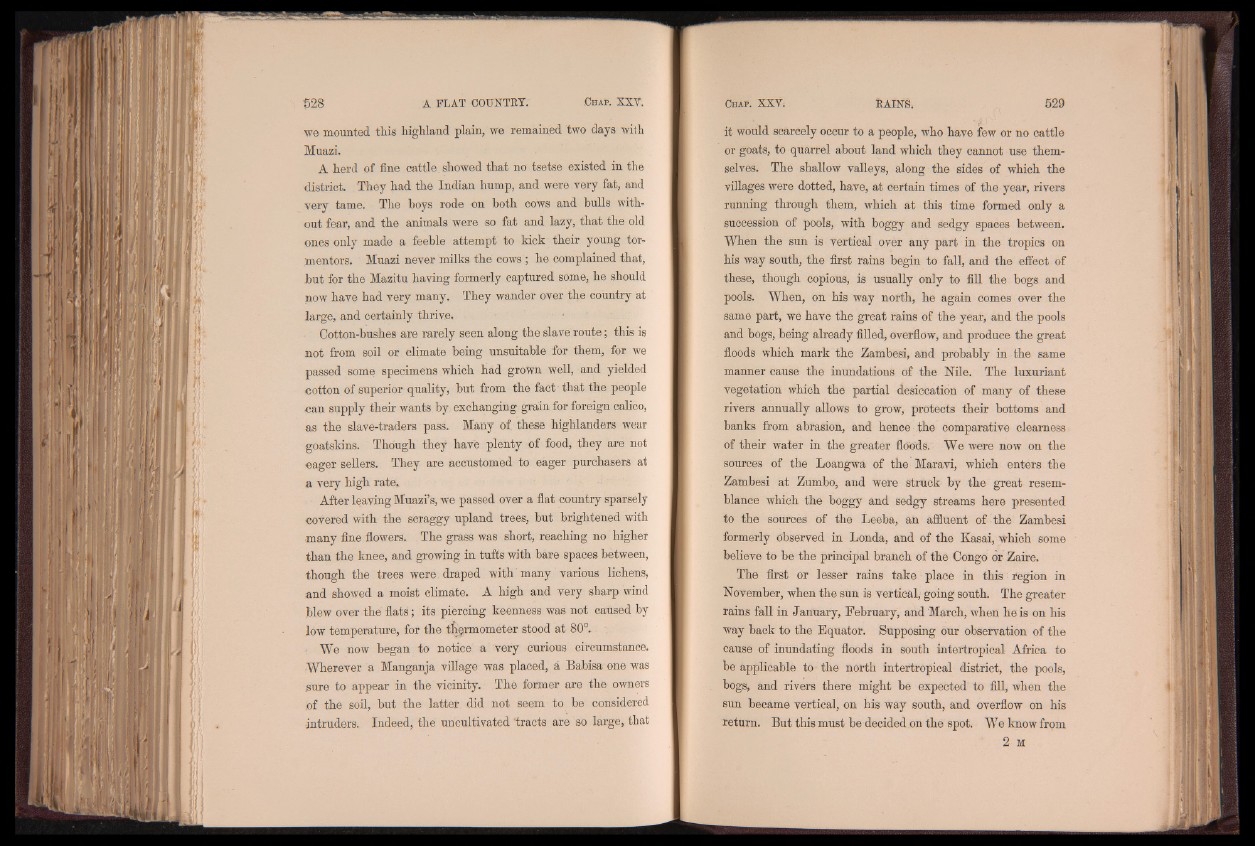
we mounted this highland plain, we remained two days with
Muazi.
A herd of fine cattle showed that no tsetse existed in the
district They had the Indian hump, and were very fat, and
very tame. The hoys rode on both cows and bulls without
fear, and the animals were so fat and lazy, that the old
ones only made a feeble attempt to kick their young tormentors.
Muazi never milks the cows ; he complained that,
but for the Mazitu having formerly captured some, he should
now have had very many. They wander over the country at
large, and certainly thrive.
Cotton-bushes are rarely seen along the slave route ; this is
not from soil or climate being unsuitable for them, for we
passed some specimens which had grown well, and yielded
cotton of superior quality, but from the fact that the people
can supply their wants by exchanging grain for foreign calico,
as the slave-traders pass. Many of these highlanders wear
goatskins. Though they have plenty of food, they are not
eager sellers. They are accustomed to eager purchasers at
a very high rate.
After leaving Muazi’s, we passed over a flat country sparsely
covered with the scraggy upland trees, but brightened with
many fine flowers. The grass was short, reaching no higher
than the knee, and growing in tufts with bare spaces between,
though the trees were draped with many various lichens,
and showed a moist climate, A high and very sharp wind
blew over the flats ; its piercing keenness was not caused by
low temperature, for the thermometer stood at 80°..
We now began to notice a very curious circumstance.
■Wherever a Manganja village was placed, à Babisa one was
sure to appear in the vicinity. Thé former are the owners
iof the soil, but the latter did not seem to be considered
intruders. Indeed, the uncultivated 'tracts are so large, that
it would scarcely occur to a people, who have few or no cattle
or goats, to quarrel about land which they cannot use themselves.
The shallow valleys, along the sides of which the
villages were dotted, have, at certain times of the year, rivers
running through them, which at this time formed only a
succession of pools, with boggy and sedgy spaces between.
When the sun is vertical over any part in the tropics on
his way south, the first rains begin to fall, and the effect of
these, though copious, is usually only to fill the bogs and
pools. When, on his way north, he again comes over the
same part, we have the great rains of the year, and the pools
and bogs, being already filled, overflow, and produce the great
floods which mark the Zambesi, and probably in the same
manner cause the inundations of the Nile. The luxuriant
vegetation which the partial desiccation of many of these
rivers annually allows to grow, protects their bottoms and
banks from abrasion, and hence the comparative clearness
of their water in the greater floods. We were now on the
sources of the Loangwa of the Maravi, which enters the
Zambesi at Zumbo, and were struck by the great resemblance
which the boggy and sedgy streams here presented
to the sources of the Leeba, an affluent of the Zambesi
formerly observed in Londa, and of the Kasai, which some
believe to be the principal branch of the Congo or Zaire.
The first or lesser rains take place in this region in
November, when the sun is vertical; going south. The greater
rains fall in January, February, and March, when he is on his
way back to the Equator. Supposing our observation of the
cause of inundating floods in south intertropical Africa to
be applicable to the north intertropical district, the pools,
bogs, and rivers there might be expected to fill, when the
sun became vertical, on his way south, and overflow on his
return. But this must be decided on the spot. We know from
2 M